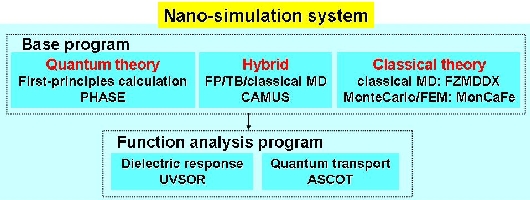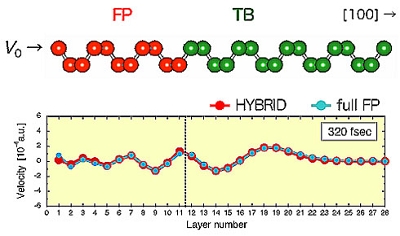Code/Method
Nano-simulation system(RSS21): PHASE, CAMUS, UVSOR, ASCOT

We have developed the Nano-simulation system collaborating with the University of Tokyo. This system contains the following programs. Using these programs, a wide variety of materials can be simulated and their properties or functions can be analyzed.
- PHASE : First-principles total-energy calculation program based on the density functional theory (DFT) and the ultrasoft pseudopotential scheme.
- CAMUS : First-principles (FP)/molecular dynamics (MD) hybrid simulation program for large scale systems. See below.
- UVSOR : First-principles dielectric-response calculation program including both electron and lattice parts.
- ASCOT : Electron transport properties calculation program, based on the non-equilibrium Green’s function (NEGF) method and the density functional theory (DFT).
See also the website, http://www.ciss.iis.u-tokyo.ac.jp/rss21/.
Multi-Scale Modeling: CAMUS
 Fig. 1 Velocity propagation simulation. Velocity distribution at 320 fsec obtained via first-principles (FP) / tight-binding (TB) hybrid simulation and full FP simulation.
Fig. 1 Velocity propagation simulation. Velocity distribution at 320 fsec obtained via first-principles (FP) / tight-binding (TB) hybrid simulation and full FP simulation.
CAMUS = Classical Ab initio MUltiscale Simulator
- Simulations of a large silicon system can be performed in higher accuracy at lower computational cost based on link atom/molecular hybrid scheme [1,2]. The accuracy of the hybrid simulation is demonstrated in Fig. 1.
- Multi-regional hybrid simulations with a concurrent use of first-principles (FP), tight-binding (TB), and molecular mechanical (MM) calculations are possible.
- PHASE, a standard FP calculation code based on the density functional theory with pseudo-potentials and plane wave basis set, is incorporated as the FP engine in CAMUS.
- Parallelized with MPI.
- Available through http://www.ciss.iis.u-tokyo.ac.jp/rss21/
References
[1] Y.Nakamura, N.Takahashi, T.Uda, T.Ohno: Phys.Rev.Lett.97, 086103 (2006).
[2] Y.Nakamura, N.Takahashi, M.Okamoto, T.Uda, T.Ohno: J.Comp.Phys.225, pp.1985-1993 (2007).
